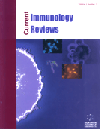- Home
- A-Z Publications
- Current Immunology Reviews (Discontinued)
- Previous Issues
- Volume 3, Issue 4, 2007
Current Immunology Reviews (Discontinued) - Volume 3, Issue 4, 2007
Volume 3, Issue 4, 2007
-
-
Regulation of Innate and Adaptive Immune Responses by a Novel Pattern Recognition Molecule Mindin
More LessAuthors: You-Wen He and David W. DraperExtracellular matrix proteins play important roles in many different biological processes. Our recent work has discovered important roles for the ECM protein mindin in both innate and adaptive immune responses. Mindin is a member of the F-spondin family of extracellular matrix proteins, which are classified by the presence of an FS1/FS2 domain and one or more thrombospondin type 1 (TSR) repeats. Mindin is highly cons Read More
-
-
-
T Cell Memory Generation in the Face of Persistent Antigen Presentation
More LessAuthors: Dawn M. Jelley-Gibbs and Susan L. SwainIn the face of emerging infectious diseases, we are challenged to develop innovative vaccine strategies that can protect against rapidly evolving and highly virulent pathogens. Since CD4 T cells are needed to generate and maintain protective B cell and CD8 T cell immunity, new vaccines should ideally elicit both T and B cell memory. In order to generate long-lived immune memory in both T and B cell compartments, such Read More
-
-
-
The Network of Fibroblastic Reticular Cells in the Lymph Node:Functional Framework for Immune Surveillance
More LessAuthors: Tomoya Katakai and Akira ShimizuLymph nodes (LNs) are crucial organs for triggering adaptive immune responses, and are localized at key places in the network of the lymphatic vascular system in order to filter tissue fluid exudates containing antigens effectively. Within the LN, immune cells are strategically compartmentalized to form a unique tissue architecture that is mechanically and functionally supported by several types of stromal cells Read More
-
-
-
To Be, or Not To Be: That is the Question-Lineage Commitment in Hematopoiesis
More LessAuthors: Motonari Kondo and Chia-Lin HsuDuring hematopoiesis, hematopoietic stem cells (HSCs) gradually lose their multi-potency and ultimately commit to a single lineage at certain period in the maturation process. Before entering the lineage commitment stage, progenitors have to go through multiple specification steps. During this progression, both external and internal cues may have effects on the cell fates of progenitors. However, it is not clear how e Read More
-
-
-
Regulation of T Cell Signaling and Function by Cbl-b
More LessAuthors: Wallace Y. Langdon and Christine B.F. ThienThe activation of intracellular signaling pathways by the engagement of ligands with cell-surface receptors is a key event in determining the fate and function of cells. While these outcomes are primarily determined by the nature of the ligand and its receptor, proteins that negatively regulate the strength and duration of these signals are also critical components in this process. In recent years the E3 ubiquitin ligases c-Cbl and Read More
-
-
-
Mechanisms of Drosophila Immunity - An Innate Immune System at Work
More LessAuthors: Ulrich Theopold and Mitchell S. DushayInsect immune systems which lack the type of adaptive immunity known in vertebrates rely on several mechanisms including solid barriers against the environment, rapid coagulation of hemolymph after wounding, the formation of aggregates that immobilize and kill foreign invaders, phagocytosis, and the production of antimicrobial peptides. The mode of action and the regulation of the expression of antimicrobial pe Read More
-
-
-
Sjogren's Syndrome and Lymphoma Development
More LessAuthors: Hisanori Umehara, Lingli Dong, Yasufumi Masaki, Masao Tanaka, Toshihiro Fukushima and Toshiro OkazakiPrimary Sjogren's syndrome (pSS) is a systemic as well as an organ-specific autoimmune disease characterized by lymphocytic infiltration of the glandular epithelial tissue. It has been reported that pSS patients have a relatively increased risk for the development of lymphoma and various factors such as cytokine stimulation, environmental exposures and viral infections as well as genetic events may contribute to the devel Read More
-
Volumes & issues
Most Read This Month
Article
content/journals/cir
Journal
10
5
false
en


